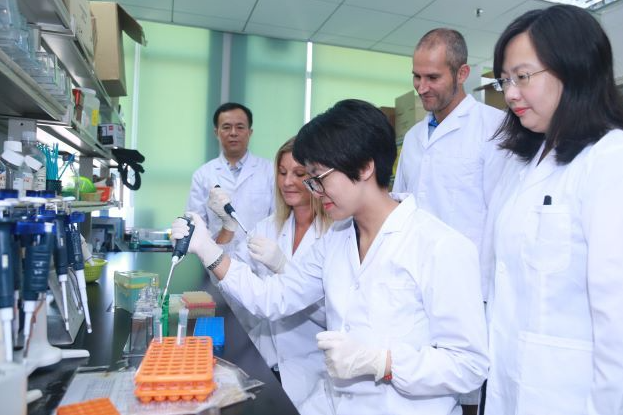核酸药物将使非酒精性脂肪性肝病和急性呼吸窘迫综合征的治疗出现转机
日期:2022年6月23日 来源:学习强国 核酸药物将使非酒精性脂肪性肝病和急性呼吸窘迫综合征的治疗出现转机 (xuexi.cn)
借着mRNA新冠疫苗的成功,核酸药物研究再一次吸引了全球生物医学科学家们的目光。而在广州,就有一个成立于两年前、全国首家拥有完全独立知识产权的核酸药物研发平台,正在悄悄进行生物医药的顶尖技术——核酸药物攻坚研究,积极探索关键核心技术,以进一步整合粤港澳大湾区医药产业资源,走出了生物医药行业高质量发展一条“广州路径”。

自主核酸药物 填补临床需求
核酸药物正逐渐成为生物医药投资的重点以及医药企业研发的热点。在人体疾病相关的致病蛋白中,超过80%的蛋白质不能被目前常规的小分子药物以及生物大分子制剂所靶向,属于不可成药蛋白质靶点。而 RNA(核糖核酸)是连接基因与蛋白质的重要桥梁,因此核酸药物不仅不受自身结构制约,能够打破“难以成药性”;还能大幅度扩展靶点范围,打破“不可成药性”,对比传统药物,其药效更加强劲持久。核酸药物被公认为对抗肿瘤、老年痴呆、糖尿病等顽疾的“利器”,也是全球新药研发的热点前沿。目前全球数亿剂 mRNA 新冠疫苗的接种验证了其效力,同时也使得整体核酸药物研发热度再度升高。
目前全球已有14款核酸药物上市,并取得了积极的市场反馈,核酸药物行业发展方兴未艾。由于国内患者群体基数较大、市场发展空间大,未来伴随我国小核酸药物开发企业的研发能力提升,我国小核酸药物市场有望迎来快速发展,逐步进入差异化创新和突破性创新阶段,尤其是针对患者群体较大的适应症药物,如乙型肝炎的潜在治愈性药物,将进一步驱动市场快速发展。
在核酸药物研发领域,中国有着特殊的地位。对于两位丹麦科学家来说,感触犹深。作为核酸药物自主知识产权研发平台Blockmir的所有者,丹麦生物医药专家Thorleif Møller正通过国家人才引进计划引入广州市黄埔区,开始深耕广州生物医药研发。Thorleif Moller和他的搭档Christina Udersen都认为,在许多技术领域如电动汽车、手机、电池等,中国市场都是全球增长最快的市场。
丹麦在生命科学研究方面虽然很强大,但它只是小市场、小国家,病人和资金都不多。中国虽然在核酸药物研发技术方面还在迎头追赶,但这是一个巨大的国家、巨大的市场。“尤其是中国投资者真的很有远见,能够看到伟大的未来。此前我们没有任何与中国打交道的经验。所以这对我们来说是一个全新的世界。确实,当人们进入新的世界时,都会有点担心和害怕,但我们与中国人的合作是迄今为止最好的经历。我们得到了开放、善意以及很多信任”。
先进技术引领 多方合作护航
Thorleif Moller坦承,近年来核酸药物开发方面主要的主要成就当然是mRNA核酸疫苗,这是在创纪录的时间内开发的产品,也是核酸药物在商业上的重大成功,一时间为核酸药物研究吸引了世界上更多目光,“也许它真的能帮助我们走出了这场流行病”。
但核酸药物的研究,更多还是将覆盖人群更广的疾病研究进展加速。“例如中枢神经系统疾病、新冠带来的呼吸系统疾病、非酒精性脂肪肝等等,在这些患病人群特别广泛的领域,我们从核酸药物的角度努力超越,也借由技术平台的不断推进,找到基因与疾病之间更直接的关系,这样药物更容易得到认可和发展。同时我们也注意连接外部的合作力量,共同把风险降到最低”。他进一步解释,核酸药物的基本理念就是超越传统的药物,传统药物是小分子和抗体,以蛋白质为目标,但只有一小部分蛋白质可以被小分子靶向,我们的技术手段将扩大目标空间,同时找到更多的靶点。
而Christina Udersen则介绍,在药物开发中,一般研究者很少去和同行分享研究成果。但Christina Udersen认为,核酸药物行业非常特殊,“它就像一个社区,选择对行业内的科学家开放,也参与建立学术合作,这为所有在这个领域工作的公司创造了一个非常强大的基础,因为大家可以互相学习”。
对于Christina Udersen而言,这也意味着当研究者进入临床试验时,有很多事情是可以预测的。因为化学成分或多或少是相同的,大多数核酸药物的副作用非常相似。这就是为什么我们可以更多地关注什么是依赖于目标机制的实际序列,而不是必须关注核酸药物共有的毒性。这也是为什么我们可以在做临床试验时可以省略一些步骤,因为我们已经从平台和“社区”中知道了很多关于核酸药物的常见化学类别。
例如,目前正与中山大学附属第一医院合作进行的针对急性呼吸窘迫综合征(ARDS)的核酸药物研究已经进入了动物实验,目前已获数据正向。数据显示,到2027年,急性呼吸窘迫综合征相关医疗设备的全球市场预计将达到169亿美元,在预测期内以7.2%的复合年增长率增长,这是由急性肺损伤和相关临床条件的发病率和发病率不断增加、人口老龄化和缺乏药物治疗所驱动的。
易感临床因素包括败血症、肺炎、吸入性创伤、胰腺炎、输血和吸入烟雾或有毒气体。针对非酒精性脂肪肝(NASH)的核酸药物研究,也已准备开展动物实验。随着人民生活水平的提高,久坐不动、营养过剩等不健康生活方式的广泛化,我国非酒精性脂肪性肝病患者数量达到2亿,已经取代病毒性肝炎成为中国第一大肝病。湖南省人民医院2020年全年体检67000余人次,其中29%检查出脂肪肝,男性多于女性,30岁以上人群发病率明显升高。以上两种疾病都是覆盖人群特别广但目前还没有专门批准使用的有效药物,核酸药物的研究无疑可望使这两种疾病治疗出现重大转机。
